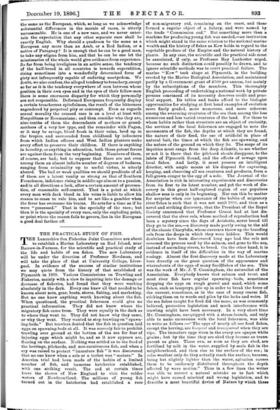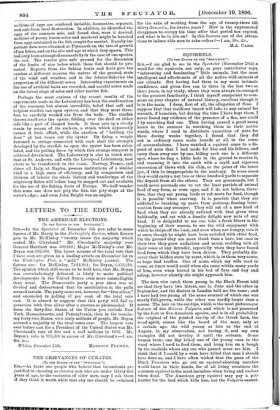THE PRACTICAL STUDY OF FISH.
THE Lancashire Sea Fisheries Joint Committee are about to establish a Marine Laboratory on Rod Island, near Barrow-in-Farness, for the scientific and practical study of the life and habits of sea fishes. The new Laboratory will be under the direction of Professor Herdman, and will take the place of that at University College, Liver- pool In evidence of the success of similar institutions we may quote from the history of that established at Plymouth in 1888. Various Commissions on Trawling and Fisheries, mainly with a view to inquiring into the damage or -decrease of fisheries, had found that they were working absolutely in the dark. Every one knew all that needed to be 'known about nets, gear, boats, stores, fishing, and marketing. But no one knew anything worth knowing about the fish. When questioned, the practical fishermen could give no practical information. They did not know where the migratory fish came from. They were equally in the dark as -to where they went to. They did not know why they came, -or why they went. They wanted to atop trawling on" spawn- ing-beds." But trawlers denied that tbe fish in question laid eggs on spawning-beds at all. It was scarcely fair to prohibit 'trawling over ground at the bottom of the sea for fear of injuring eggs which might be, and as it now appears are, floating on the surface. Nothing was settled as to the food of the herrings, pilchards, and non-carnivorous fish, and when a cry was raised to protect "immature fish " it was discovered that no one knew when a sole or a turbot was "mature." In America trial bad been made of the habits of a limited -number of fish, and immense hatcheries established, -with one striking result. The cod at certain times leave the shores of New England to visit the colder waters of Newfoundland. The millions of young fish turned out in the hatcheries had established a race of non-migratory cod, remaining on the coast, and these formed a regular object of a fishery, and were named by the trade "Commission cod." But something more than a machine for producing young fish was needed,—an institution which might stand in the same relation to the national marine wealth and the history of fishes as Kew holds in regard to the vegetable produce of the Empire and the natural history of plants. In any case, the scientific and the practical side mast be associated, if only, as Professor Ray Lankester urged, because no such distinction could possibly be drawn, and to ignore scientific methods was to court practical failure. The marine " Kew " took shape at Plymouth, in the building erected by the Marine Biological Association, and maintained partly by a Government grant of 2500 per annum, but mainly by the subscriptions of the members. This thoroughly English proceeding of undertaking a national work by private persons convinced of its necessity deserves credit and prac- tical support. Its tables and tanks afford to the biologist opportunities for studying at first hand examples of evolution more finely graded, more numerous, and more coherent among the swarming creatures of the sea than among the less numerous and less varied creatures of the land. For those to whom habits rather than structure are an object of curiosity, the services of the local fishermen are engaged to note the movements of the fish, the depths at which they are found, the nature of their food, the use of artificial in place of natural bait, the times at which the fish are spawning, and the nature of the ground on which they lie. The scope of its inquiries must range from the deep Atlantic, to see whether or not it is there that the pilchard shoals disappear, to the inlets of Plymouth Sound, and the effects of sewage upon local fishes. And lastly, it must possess an intelligent director, with ample means at his disposal for capturing, keeping, and observing all sea creatures and products, from a full-grown conger to the egg of a sole. The Journal of the Association is rich in interesting experiments and discoveries from its first to its latest number, and yet the work of dis- covery in this great half-explored region of our populous shallow seas is only in its beginning. Nor can this be matter for surprise when our ignorance of the habits of migratory river fishes is such that it was not until 1896, and then as a novel and striking discovery, that the President of the Royal Society announced that Professor Grassi had at last dis- covered that the river eels, whose method of reproduction had been a mystery since the days of Aristotle, never breed till they go to the sea,—a discovery made partly owing to the aid of the classic Charybdis, whose currents threw up the breeding eels from the deeps in which they were hidden. This would doubtless have been discovered long ago had the eels not reversed the process used by the salmon, and gone to the sea, instead of ascending rivers, to breed. On the other hand, it is evidence in itself of the difficulties in the way of marine zoology. Almost the first discovery made at the Laboratory bore directly on the great question of the appearance and whereabouts of the eggs of many foodifishes of the sea. This was the work of Mr. J. T. Cunningham, the naturalist of the Association. Everybody knows that salmon and trout and most river fish have regular spawning - beds, sometimes dropping the eggs on rough gravel and sand, which some fishes, such as lampreys, pile up in order to break the force of the current, sometimes, as in the case of many coarse fish, sticking them on to weeds and piles by the locks and weirs. If the sea fishes caught for food did the same, as was commonly believed, protective legislation and much interference with trawling might have been necessary. In a very short time Mr. Cunningham, unequipped with a steam-launch, and only able to make excursions with the local fishermen, was able to write as follows :—" The eggs of nearly all our food fishes, except the herring, are buoyant and transparent when they are ripe. The immature eggs when in the ovary are opaque white grains ; but by the time they are shed they become as trans- parent as glass. These ova, as soon as they are shed, are fertilised by milt in the water, supplied by male fish in the neighbourhood, and then rise to the surface of the sea ; in calm weather only do they actually reach the surface, because, being bat slightly lighter than the water, agitation causes them to be uniformly distributed throughout the depth affected by wave motion." Thus in a few lines the writer was able to correct a natural mistake as to fact which might have caused mischief and wrong legislation, and to describe a most beautiful device of Nature by which these
millions of eggs are rendered invisible, locomotive, separate, and safe from local destruction. In addition, he identified the eggs of the common sole, and found that, were it desired, millions of young lemon-soles and mackerel might be hatched from eggs contained in the fish caught for market. Equally im- portant data were obtained at Plymouth on the rate of growth of sea fishes, and on the size and age at which they spawn. This had only been attempted successfully in the case of one species, the cod. The results give safe ground for the discussion of the limits of size below which these fish should be pro- tected. Reports from the fishing boats and fleets give the catches at different seasons, the nature of the ground, state of the wind and weather, and in the lobster-fisheries the proportion of the different sexes. Interesting experiments on the use of artificial baits are recorded, and careful notes made on the larval stage of soles and other marine fish.
Perhaps the most curious of the recent results of the experiments made at the Laboratory has been the confirmation of the common, but almost incredible, belief that soft and helpless starfish can open oysters, and that they must there- fore be carefully weeded out from the beds. The starfish throws itself over the oyster, folding over the shell on either side like a pair of clasped hands. It then sets up a steady strain by means of its suckers, a strain which apparently causes it little effort, while the exertion of "holding the door" at last wears out the oyster. By fixing a weight fastened to strings connected with each shell the strength developed by the starfish to open the oyster has been calcu- lated, and the pulling force by which this strange conquest is achieved determined. The Laboratory is also in touch with that at St. Andrews, and with the Liverpool Laboratory, now about to be transferred to the coast. Norway, France, and above all Italy, at Naples, possess institutions of a similar kind in a high state of efficiency, and by comparison and division of labour the whole history and wanderings of the migratory fishes will before long be mapped out and available for the use of the fishing fleets of Europe. We half wonder that some one does not pity the fish, but pity stops at the water's edge; and even John Bright was an angler.











































 Previous page
Previous page